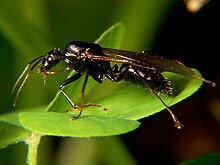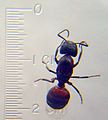| Revision as of 20:14, 12 December 2007 edit72.230.102.32 (talk) →Species← Previous edit | Revision as of 20:14, 12 December 2007 edit undoAitias (talk | contribs)Rollbackers50,076 edits Restored revision 172380661 by AnteaterZot (mistakenly reverted/problems? → FAQ)Next edit → | ||
| Line 28: | Line 28: | ||
| All ants in this genus possess an ] ]l ] called '']''. This bacterium has a small genome, and retains genes to biosynthesize essential ] and other nutrients. This suggests the bacterium plays a role in ant nutrition. Many ''Camponotus'' species are also infected with '']'', another endosymbiont that is widespread across insect groups. | All ants in this genus possess an ] ]l ] called '']''. This bacterium has a small genome, and retains genes to biosynthesize essential ] and other nutrients. This suggests the bacterium plays a role in ant nutrition. Many ''Camponotus'' species are also infected with '']'', another endosymbiont that is widespread across insect groups. | ||
| == Species == | |||
| This list of species is incomplete, see ] for a complete listing of species and subspecies. | |||
| * '']'' - one of the many kinds of carpenter ants that can bite and release a painful acid. | |||
| * '']'' | |||
| * '']'' — sugar ant | |||
| * '']'' Mayr, 1862 | |||
| * '']'' (Fab.) — red carpenter ant | |||
| * '']'' | |||
| * '']'' | |||
| * '']'' | |||
| * '']'' — an important species in ] | |||
| * '']'' (Emery) — smaller carpenter ant | |||
| * '']'' (DeGeer) — black carpenter ant | |||
| * '']'' (Mayr) — Tacuru ant | |||
| * '']'' — Malaysian ant | |||
| * '']'' | |||
| * '']'' | |||
| * '']'' | |||
| <gallery> | |||
| Image:Carpenter ants.jpg | |||
| Image:Holzschaden.jpg | |||
| Image:Rossameise.JPG | |||
| </gallery> | |||
| ==External links== | ==External links== | ||
Revision as of 20:14, 12 December 2007
| Carpenter ant | |
|---|---|

| |
| Camponotus herculeanus (Worker) | |

| |
| Camponotus pennsylvanicus (Winged Male) | |
| Scientific classification | |
| Kingdom: | Animalia |
| Phylum: | Arthropoda |
| Class: | Insecta |
| Order: | Hymenoptera |
| Family: | Formicidae |
| Subfamily: | Formicinae |
| Tribe: | Camponotini |
| Genus: | Camponotus |
| Species | |
|
See text. | |
| Diversity | |
| 1017 species | |
Carpenter ants are large ants (¼ in–1 in) indigenous to many parts of the world. They prefer dead, damp wood in which to build nests. Sometimes carpenter ants will hollow out sections of trees. The most likely species to be infesting a house is the Black carpenter ant, Camponotus pennsylvanicus.
All ants in this genus possess an obligate bacterial endosymbiont called Blochmannia. This bacterium has a small genome, and retains genes to biosynthesize essential amino acids and other nutrients. This suggests the bacterium plays a role in ant nutrition. Many Camponotus species are also infected with Wolbachia, another endosymbiont that is widespread across insect groups.
Species
This list of species is incomplete, see List of Camponotus species for a complete listing of species and subspecies.
- Camponotus atriceps - one of the many kinds of carpenter ants that can bite and release a painful acid.
- Camponotus chromaiodes
- Camponotus consobrinus — sugar ant
- Camponotus crassus Mayr, 1862
- Camponotus ferrugineus (Fab.) — red carpenter ant
- Camponotus gigas
- Camponotus herculeanus
- Camponotus kaura
- Camponotus ligniperda — an important species in Europe
- Camponotus nearcticus (Emery) — smaller carpenter ant
- Camponotus pennsylvanicus (DeGeer) — black carpenter ant
- Camponotus punctulatus (Mayr) — Tacuru ant
- Camponotus saundersi — Malaysian ant
- Camponotus sericeus
- Camponotus taino
- Camponotus variegatus
External links
- University of Kentucky Extension Fact Sheet
- Ohio State University Extension Fact Sheet
- Black Carpenter Ants Diagnostic large format photographs, information
- Harvard University Fact Sheet on Carpenter Ants
- Information On Carpenter Ant Treatment
This ant-related article is a stub. You can help Misplaced Pages by expanding it. |


